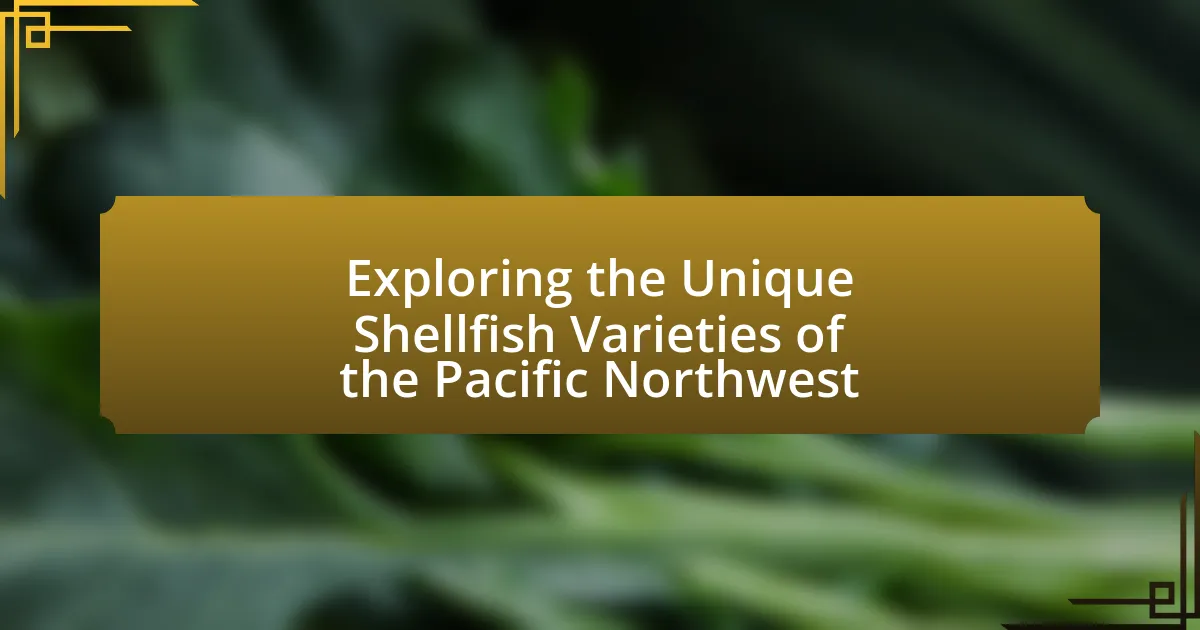The article explores the unique shellfish varieties of the Pacific Northwest, highlighting species such as geoduck, Manila clams, Pacific oysters, and Dungeness crab. It examines how these shellfish differ from those in other regions due to specific environmental factors, including water temperature and salinity. The article also discusses local culinary traditions that influence the preparation and consumption of these shellfish, the importance of conservation efforts for maintaining biodiversity, and the role of local fisheries in promoting sustainability. Additionally, it provides insights into best practices for sourcing and enjoying shellfish sustainably, along with culinary tips to enhance the dining experience.

What are the Unique Shellfish Varieties of the Pacific Northwest?
The unique shellfish varieties of the Pacific Northwest include geoduck, Manila clams, Pacific oysters, and Dungeness crab. Geoduck, known for its large size and distinctive appearance, can weigh over 3 pounds and is highly sought after for its sweet flavor. Manila clams, small and sweet, thrive in the region’s sandy beaches and are popular in various culinary dishes. Pacific oysters, cultivated in the region’s nutrient-rich waters, are renowned for their briny taste and are a staple in seafood cuisine. Dungeness crab, characterized by its sweet, tender meat, is a commercially important species and is often harvested during the winter months. These shellfish varieties contribute significantly to the local economy and culinary culture, making the Pacific Northwest a prime destination for seafood enthusiasts.
How do these shellfish varieties differ from those in other regions?
Shellfish varieties in the Pacific Northwest differ from those in other regions primarily due to their unique environmental conditions and species diversity. The cold, nutrient-rich waters of the Pacific Northwest support a variety of shellfish, such as geoduck clams, Dungeness crabs, and Pacific oysters, which thrive in these specific habitats. In contrast, regions like the Gulf of Mexico or the Atlantic coast feature different species, such as blue crabs and eastern oysters, which are adapted to warmer waters and different ecological conditions. The distinct flavors and textures of Pacific Northwest shellfish are influenced by the region’s specific salinity levels, water temperatures, and food sources, making them unique compared to shellfish from other areas.
What environmental factors contribute to the uniqueness of these shellfish?
The environmental factors that contribute to the uniqueness of shellfish in the Pacific Northwest include water temperature, salinity, nutrient availability, and habitat diversity. These factors create specific ecological niches that support a wide variety of shellfish species. For instance, the region’s coastal waters experience significant upwelling, which brings nutrient-rich waters to the surface, fostering abundant phytoplankton growth that serves as a primary food source for many shellfish. Additionally, the varying salinity levels due to freshwater influx from rivers and estuaries influence species distribution and adaptation. The diverse habitats, such as rocky shores, sandy beaches, and tidal flats, provide different microenvironments that cater to the unique life cycles and behaviors of various shellfish species, enhancing their ecological diversity.
How do local culinary traditions influence the use of these shellfish?
Local culinary traditions significantly influence the use of shellfish in the Pacific Northwest by dictating preparation methods, flavor pairings, and seasonal harvesting practices. For instance, indigenous communities have historically utilized shellfish such as geoduck and razor clams in traditional dishes, emphasizing techniques like steaming and grilling that enhance their natural flavors. Additionally, contemporary culinary practices in the region often incorporate local ingredients, such as foraged herbs and regional spices, to complement the shellfish, reflecting a farm-to-table ethos that prioritizes freshness and sustainability. This integration of local flavors and cooking methods not only preserves cultural heritage but also adapts to modern tastes, showcasing the versatility of shellfish in various culinary contexts.
What are the most popular shellfish species found in the Pacific Northwest?
The most popular shellfish species found in the Pacific Northwest include Dungeness crab, Pacific oysters, and Manila clams. Dungeness crab is highly sought after for its sweet, tender meat and is a staple in local fisheries, with commercial landings exceeding 20 million pounds annually. Pacific oysters are prized for their unique flavor and are cultivated extensively in the region, contributing significantly to the aquaculture industry. Manila clams are also popular due to their sweet taste and are commonly harvested along the coast, with recreational and commercial fishing practices supporting their availability.
What characteristics define each of these popular species?
The characteristics that define popular shellfish species in the Pacific Northwest include distinct physical traits, habitat preferences, and culinary uses. For instance, Dungeness crab is known for its sweet, tender meat and a hard shell that can reach up to 8 inches across, typically found in sandy or muddy substrates along the coast. Manila clams are characterized by their smooth, rounded shells, usually 2 to 3 inches in size, and thrive in intertidal zones, making them a popular choice for steaming and baking. Oysters, particularly the Pacific oyster, have a rough, irregular shell and are often cultivated in estuarine environments; they are prized for their briny flavor and are commonly served raw. Each species exhibits unique adaptations that enhance their survival and appeal in culinary contexts.
How are these species harvested and prepared?
Shellfish species in the Pacific Northwest are typically harvested through methods such as hand gathering, dredging, and trapping. Hand gathering involves individuals collecting shellfish directly from tidal zones, while dredging uses specialized equipment to scrape shellfish from the ocean floor. Trapping employs baited traps to capture species like crabs.
After harvesting, shellfish are prepared through various cooking methods, including steaming, boiling, grilling, and baking. For instance, clams and mussels are often steamed until they open, indicating they are cooked, while oysters can be enjoyed raw or grilled. These preparation methods enhance the natural flavors of the shellfish, making them a popular choice in regional cuisine.
Why is the conservation of shellfish in the Pacific Northwest important?
The conservation of shellfish in the Pacific Northwest is crucial for maintaining biodiversity and supporting local ecosystems. Shellfish, such as clams, oysters, and crabs, play a vital role in nutrient cycling and habitat formation, which benefits other marine species. Additionally, the shellfish industry significantly contributes to the regional economy, with the Pacific Northwest producing over 90% of the nation’s farmed oysters. Protecting shellfish populations ensures sustainable fisheries, preserves cultural heritage, and enhances water quality by filtering pollutants.
What threats do these shellfish face in their natural habitats?
Shellfish in the Pacific Northwest face several significant threats in their natural habitats, including habitat degradation, pollution, climate change, and overfishing. Habitat degradation occurs due to coastal development and the destruction of estuaries, which are crucial for shellfish reproduction and growth. Pollution from agricultural runoff and industrial waste introduces harmful chemicals and pathogens into their environments, negatively impacting their health and survival rates. Climate change leads to ocean acidification and rising temperatures, which can disrupt shellfish growth and reproduction. Overfishing further exacerbates the decline of shellfish populations, as unsustainable harvesting practices reduce their numbers and genetic diversity. These threats collectively jeopardize the ecological balance and sustainability of shellfish species in the region.
How do conservation efforts impact local ecosystems and communities?
Conservation efforts positively impact local ecosystems and communities by promoting biodiversity and sustainable resource management. For instance, initiatives aimed at protecting shellfish habitats in the Pacific Northwest enhance water quality and support the overall health of marine ecosystems. Research indicates that healthy shellfish populations contribute to nutrient cycling and habitat stability, which benefits various marine species. Additionally, these conservation efforts often involve local communities in stewardship activities, fostering economic opportunities through sustainable fisheries and ecotourism. A study by the National Oceanic and Atmospheric Administration highlights that communities engaged in conservation see increased resilience against environmental changes, thereby reinforcing the socio-economic fabric of the region.
How can one experience the shellfish culture of the Pacific Northwest?
To experience the shellfish culture of the Pacific Northwest, one can participate in local shellfish harvesting events, visit shellfish farms, and dine at restaurants specializing in regional seafood. Engaging in activities such as clam digging on the beaches of Washington or attending festivals like the annual Dungeness Crab and Seafood Festival in Port Angeles allows individuals to immerse themselves in the local shellfish traditions. Additionally, visiting aquaculture farms, such as Taylor Shellfish Farms, provides insight into sustainable shellfish farming practices and the variety of species cultivated in the region, including geoducks and Manila clams. These experiences highlight the significance of shellfish in the local economy and culture, showcasing the Pacific Northwest’s rich maritime heritage.
What are the best practices for sourcing and consuming shellfish sustainably?
The best practices for sourcing and consuming shellfish sustainably include choosing certified seafood, supporting local fisheries, and being aware of seasonal availability. Certified seafood, such as those labeled by the Marine Stewardship Council, ensures that the shellfish are harvested in a way that maintains healthy populations and ecosystems. Supporting local fisheries helps reduce the carbon footprint associated with transportation and promotes the economic viability of regional fishing communities. Additionally, consuming shellfish during their peak seasons allows for better management of stocks and ensures that the shellfish are at their most abundant and healthy. These practices contribute to the long-term sustainability of shellfish populations and their habitats.
How can consumers identify sustainably harvested shellfish?
Consumers can identify sustainably harvested shellfish by looking for certifications from recognized organizations such as the Marine Stewardship Council (MSC) or the Aquaculture Stewardship Council (ASC). These certifications indicate that the shellfish have been sourced from fisheries or farms that adhere to sustainable practices, ensuring minimal environmental impact and responsible management of marine resources. Additionally, consumers can inquire about the harvesting methods used, as methods like hand-harvesting or traps are generally more sustainable than dredging. Research shows that certified fisheries have a lower likelihood of overfishing and contribute to healthier ecosystems, making these certifications a reliable indicator of sustainability.
What role do local fisheries play in promoting sustainability?
Local fisheries play a crucial role in promoting sustainability by managing fish populations and ecosystems responsibly. They implement practices such as selective harvesting and habitat restoration, which help maintain biodiversity and prevent overfishing. For instance, the Pacific Northwest’s local fisheries often engage in community-based management, ensuring that fishing practices align with ecological health and local regulations. This approach not only supports the sustainability of shellfish varieties but also contributes to the resilience of marine ecosystems, as evidenced by the recovery of certain species due to regulated fishing efforts.
What culinary tips can enhance the enjoyment of Pacific Northwest shellfish?
To enhance the enjoyment of Pacific Northwest shellfish, focus on fresh, local ingredients and simple preparation methods. Freshness is crucial; shellfish should be sourced from reputable suppliers to ensure optimal flavor and texture. Cooking techniques such as steaming, grilling, or sautéing preserve the natural taste without overpowering it. Pairing shellfish with complementary flavors like garlic, lemon, and herbs enhances their inherent qualities. For example, Dungeness crab is often best enjoyed with melted butter and a squeeze of lemon, while oysters can be elevated with mignonette sauce or hot sauce. These methods not only highlight the unique characteristics of Pacific Northwest shellfish but also create a memorable dining experience.

Leave a Reply